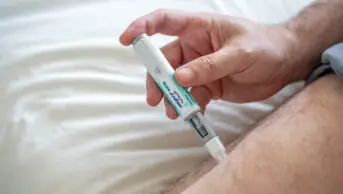
Digicomphoto / Science Photo Library
Glucagon-like peptide-1 (GLP-1) receptor agonists target the incretin system, thereby stimulating insulin secretion. They are potent and have been proven to reduce cardiovascular events, improve renal disease progression and aid weight loss. This makes them an attractive option for patients and clinicians because many complications associated with diabetes are linked with these comorbidities.
The benefits of GLP-1 receptor agonists can be seen as early as two to five years from initiation and therefore should be considered early on in the treatment pathway. The European Association for the Study of Diabetes/American Diabetes Association consensus guideline also recommends this, hence a real ‘call for action’ is required to improve patient access to ‘gold standard’ treatment.
However, currently, GLP-1 receptor agonists are often seen as a last resort or secondary care treatment option, with 76.1% of GPs claiming to not have sufficient time or knowledge to initiate them. In some GP practices, there may also be an overreliance on secondary care teams and a lack of financial incentive to manage more complex patients with diabetes in-house.
Patients were grateful to be seen face to face, especially since the pandemic left many isolated and disengaged
As a result, I decided to conduct a quality improvement project to improve glycaemic control in patients with diabetes and upskill myself to provide more specialist care in-house.
I completed non-promotional MERIT training through Novo Nordisk to initiate injectable therapy and received ongoing support from a nurse consultant, which has built my confidence in expanding my scope of practice.
I started by identifying obese patients with diabetes, who had poor glycaemic control, registered with two GP practices in Haringey, north London (see Table). I then reviewed each patient in person when injectable therapy was initiated and followed them up each month to review their treatment until the maximum tolerated treatment was established or the therapeutic aims were achieved. Insulin patients were followed up more closely.

CKD: chronic kidney disease; CVD: cardiovascular disease; NAFLD: non-alcoholic fatty liver disease
Improvement in glycaemic control is achieved more quickly when managed in primary care. This is owing to reduced delays from onward referrals, more frequent follow up and the opportunity to take a shared decision-making approach. Patients were grateful to be seen face to face, especially since the COVID-19 pandemic left many isolated and disengaged.
There were no dedicated clinics for this work so it was conducted on an ad hoc basis or based on opportunistic patient reviews and therefore data were only collated for 19 patients over a six-month period.
Another challenge was a lack of administrative support owing to a lack of resources; for instance, administrative staffing issues during the pandemic or limited availability of local phlebotomy services. However, I found that having in-house phlebotomy services improved patient attendance to appointments.
Given that patients with diabetes form the largest ‘quality outcomes framework’ list, some administrative support should now be directed to support these patients and ensure they are not lost to follow-up, especially given the backlog from the pandemic.
From a therapeutic aims perspective, the data show the project went well. Patients verbally expressed satisfaction with the service as there was a clear point of contact and continuity of care within the practice. I could also use the consultation to tackle comorbidities, such as hypertension, chronic kidney disease or hypercholesterolaemia, to ensure the patients were being reviewed holistically. This was well received by the practices — although this proactive approach required an average of three appointments, they felt it led to less fragmented care and a better patient experience.
I was able to share my knowledge with the practice teams and have started to lead on GLP-1 receptor agonist training for other pharmacists
Personally, being able to apply my knowledge and skills to improve patient outcomes was rewarding and improved my overall job satisfaction. I was able to share my knowledge and interventions with the practice teams and have started to lead on GLP-1 receptor agonist training for other pharmacists in the locality, which is the first step towards expanding the project.
At the time, there was no virtual clinic model between primary and secondary care teams in my locality and this is likely to be applicable to many other localities and areas of speciality. Therefore, I would encourage pharmacists working in primary care to pursue their areas of interest regardless of the support available to them locally. For instance, the training and mentorship I received was sought independently and there are not many such free opportunities available to primary care pharmacists, especially since the COVID-19 pandemic.
When it is more specialist work, such as with diabetic injectables, and nobody else in your locality can support you, you can always consider sending an ‘advice and guidance’ to your local specialist team. You can also keep a track of recommendations made by specialists through documents sent your way to learn from their decision making.
It is also important to have a supportive manager and some autonomy with your clinics. This ensures there is a balance between local and national workstreams, as well as exposure to clinical areas of interest.
Shivani Patel is a senior clinical pharmacist at Haringey GP Federation in north London
1 comment
You must be logged in to post a comment.



No mention of whether this is a second or third step? Would have been good to get an example or two